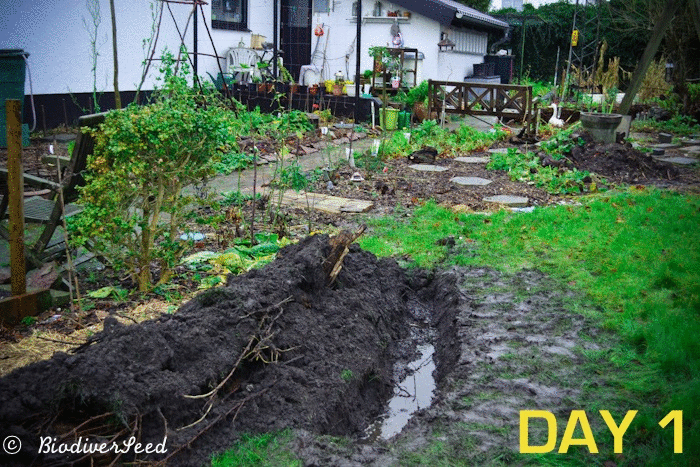

Andria/Flickr
In Denmark, where I live, we experience an average of 171 rainy days a year. Living in a biome where excess precipitation is a problem, designing the grade of the garden with the flow of water in mind has been crucial.
Last year, I began digging out swales—vegetated meandering canals—while piling up the excess soil in berms—vegetated raised banks. These two structures work together to channel water to rain gardens—depressed areas planted with flood-tolerant plants, where water can percolate into the soil. The relief these depressions and channels provided to a saturated landscape was evident in a matter of days.

Lynsey Grosfield
Over time, I’ve worked with planting the raised hügelkultur berms (pictured above) as “meadow gardens,” and planting water-purifying plants, such as semi-aquatic irises, in the swales. These moisture-loving plants provide the ecological service of hyperaccumulating pollutants, like heavy metals, and generally remediate the quality of any standing water, making it less prone to algal growth.

University of Minnesota/Flickr
Although they are unfinished as of yet, the canals, once fully lined with landscaping fabric, will also become an an attractive rock feature, mimicking a dry creek bed and natural-looking flowering embankment. The irises are planted at the lowest point, where it is most moist.

Lynsey Grosfield
Eventually, the whole drainage system will lead to a rain garden. These depressed gardens can be planted with any number of water loving trees, shrubs and herbaceous perennials—the only requirement being that they tolerate or thrive in water-saturated soil.
The larger surface area of the whole system allows for faster absorption of water into the landscape, and also faster evaporation, all the while channelling water away from trees, shrubs, and herbaceous plants that have less tolerance for standing water.

Lynsey Grosfield
A swale, berm and rain garden system is a DIY take on what urban planners would call a stormwater cell. In a manner similar to a natural wetland, it provides a place for excess water to gather and slowly return to the soil. Unlike a natural wetland, however, this system limits the amount of time standing water is in the garden, ideally preventing pests, like mosquitoes, from having enough time to spawn a generation.
So if you have excess water in the garden, consider channelling it to places where well-adapted plants can purify it as it soaks into the water table.
About the Author: Lynsey Grosfield is the founder of BiodiverSeed, a global seed swap network devoted to the exchange of self-harvested, organic and heirloom seeds with the goal of preserving maximum genetic diversity. Follow BiodiverSeed on Twitter.




